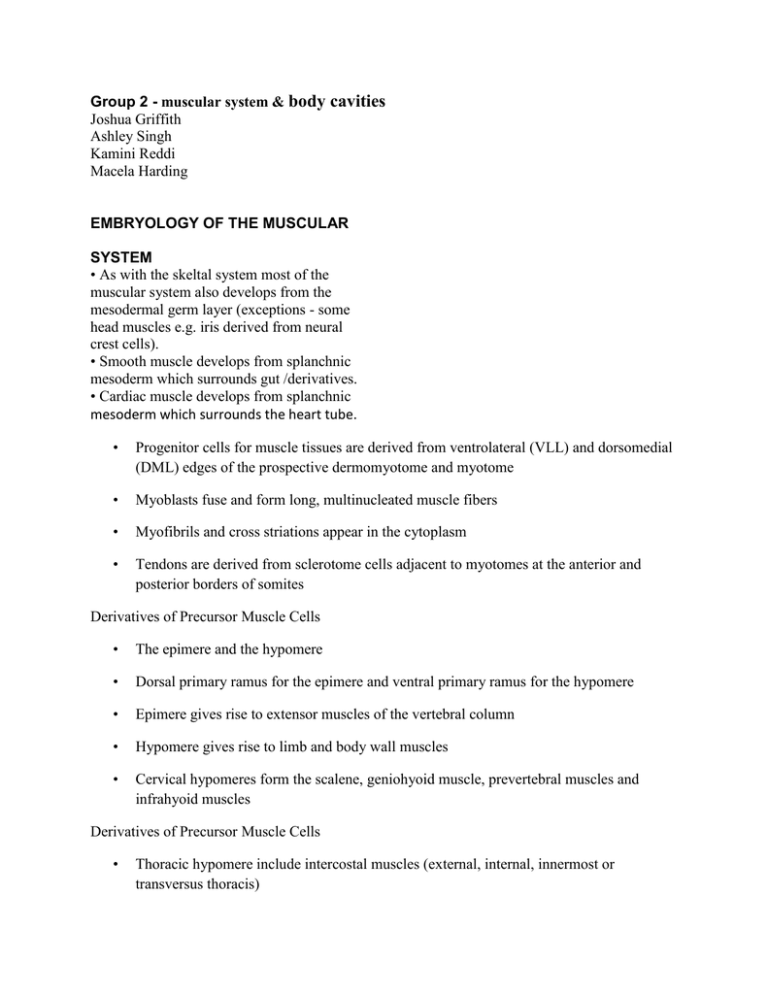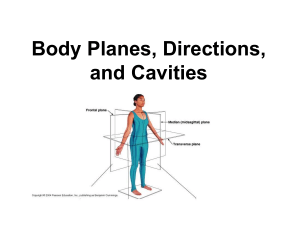body cavities
advertisement

Group 2 - muscular system & body cavities Joshua Griffith Ashley Singh Kamini Reddi Macela Harding EMBRYOLOGY OF THE MUSCULAR SYSTEM • As with the skeltal system most of the muscular system also develops from the mesodermal germ layer (exceptions - some head muscles e.g. iris derived from neural crest cells). • Smooth muscle develops from splanchnic mesoderm which surrounds gut /derivatives. • Cardiac muscle develops from splanchnic mesoderm which surrounds the heart tube. • Progenitor cells for muscle tissues are derived from ventrolateral (VLL) and dorsomedial (DML) edges of the prospective dermomyotome and myotome • Myoblasts fuse and form long, multinucleated muscle fibers • Myofibrils and cross striations appear in the cytoplasm • Tendons are derived from sclerotome cells adjacent to myotomes at the anterior and posterior borders of somites Derivatives of Precursor Muscle Cells • The epimere and the hypomere • Dorsal primary ramus for the epimere and ventral primary ramus for the hypomere • Epimere gives rise to extensor muscles of the vertebral column • Hypomere gives rise to limb and body wall muscles • Cervical hypomeres form the scalene, geniohyoid muscle, prevertebral muscles and infrahyoid muscles Derivatives of Precursor Muscle Cells • Thoracic hypomere include intercostal muscles (external, internal, innermost or transversus thoracis) • External oblique, internal oblique, transversus abdominis, and rectus abdominis (sternalis in thorax) in the ventrolateral abdominal wall • Lumbar segments (lumborum muscle) • Sacral and coccygeal region (pelvic diaphragm and striated muscles of the anus) Limb Musculature • Condensation of mesenchyme near the base of limb buds (7th week) • Mesenchyme is derived from dorsolateral cells of somites • Migrate into limb bud to form the muscles • Connective tissue dictates the pattern of muscle formation • Upper limb buds lie opposite the lower five cervical and upper two thoracic segments • There is a 180° medial rotation of the lower limb compared to developing upper limb (angle of flexion differs) Smooth Muscle • Dorsal aorta and large arteries lateral plate mesoderm and neural crest cells • Coronary arteries proepicardial and neural crest cells • Wall of the gut and gut derivatives lateral plate mesoderm (splanchnic layer) • Sphincter and dilator (pupil) muscles, muscle tissue in the mammary and sweat glands ectoderm • Clinical Correlations BODY CAVITIES, MESENTERIES & DIAPHRAGM INTRAEMBRYONIC COELOM INTRAEMBRYONIC COELOM • Appears as isolated spaces in the lateral mesoderm • In the 4th week, the spaces fuse to form a single horseshoe-shaped (U-shaped) cavity • The coelom divides the lateral mesoderm into: 1. Somatic (parietal) layer: under ectoderm 2. Splanchnic (visceral) layer: over endoderm • Somatopleure = somatic mesoderm + overlying ectoderm • Splanchnopleure = splanchnic mesoderm + underlying endoderm • DERIVATIVES: It gives rise to three body cavities: 1. A pericardial cavity: the curve of U 2. Two pericardioperitoneal canals (future pleural cavities): the proximal parts of the limbs of U 3. Two peritoneal cavities: the distal parts of the limbs of U • Each cavity has a parietal layer (derived from somatic mesoderm) & a visceral layer (derived from visceral mesoderm) • FUNCTION: It provides space for the organs to develop & move DEVELOPMENT OF PERITONEAL CAVITY • Major part of intraembryonic coelom • Develop from the distal parts of the limbs of the U-shaped cavity • Originally, it is connected with extraembryonic coelom (midgut herniates to the outside through this connection) • At 10th week, it looses its connection with extraembryonic ceolom (when midgut returns to abdomen) MESENTERIES • A MESENTERY is a double layer of peritoneum that begins as an extension of the visceral peritoneum covering an organ • The mesentery connects the organ to the body wall and transmits vessels and nerves to it • Transiently, the dorsal & ventral mesenteries divide the peritoneal cavity into right & left halves • The ventral mesentery disappears EXCEPT where stomach develops PERICARDIAL CAVITY • Develops from the curve of the U-shaped cavity • During formation of head fold, the heart & pericardial cavity move ventrocaudally & become anterior to the foregut (esophagus) • It is bounded by an outer somatic & an inner visceral layer, forming the serous pericardium PERICARDIAL CAVITY • Originally, it is connected with the 2 pericardioperitoneal canals • Later on, it become separated from the 2 pericardioperitoneal canals PERICARDIAL CAVITY • Originally, the bronchial buds are small relative to the heart • Bronchial buds grow laterally into pericardioperitoneal canals (future pleural cavities) • Pleural cavities expand ventrally around heart & splits mesoderm into: 1. Outer layer: forms thoracic wall 2. Inner layer: pleuropericardial membrane PLEUROPERICARDIAL MEMBRANES • THE PARTS SURROUNDING THE SEROUS PERICARDIUM: form the fibrous pericardium • THE PARTS BEHIND THE HEART: fuse with the ventral mesentery of the esophagus (at 7th week), forming the mediastinum & separating pericardial from pleural cavities • N.B.: The right pleural cavity separates from pericardial cavity earlier than left PLEURAL CAVITIES • Develop from the 2 pericardiperitoneal canals • Originally, they are connected with pericardial & peritoneal cavities • Later on, they become separated from: 1. Pericardial cavity 2.Peritoneal cavity PLEUROPERITONEAL MEMBRANES• Produced when developing lungs & pleural cavities expand into the body wall • During 6th week, they fuse with dorsal mesentery of esophagus & septum transversum, separating pleural cavities from peritoneal cavity • N.B.: The right pleural cavity separates from peritoneal cavity earlier than left







